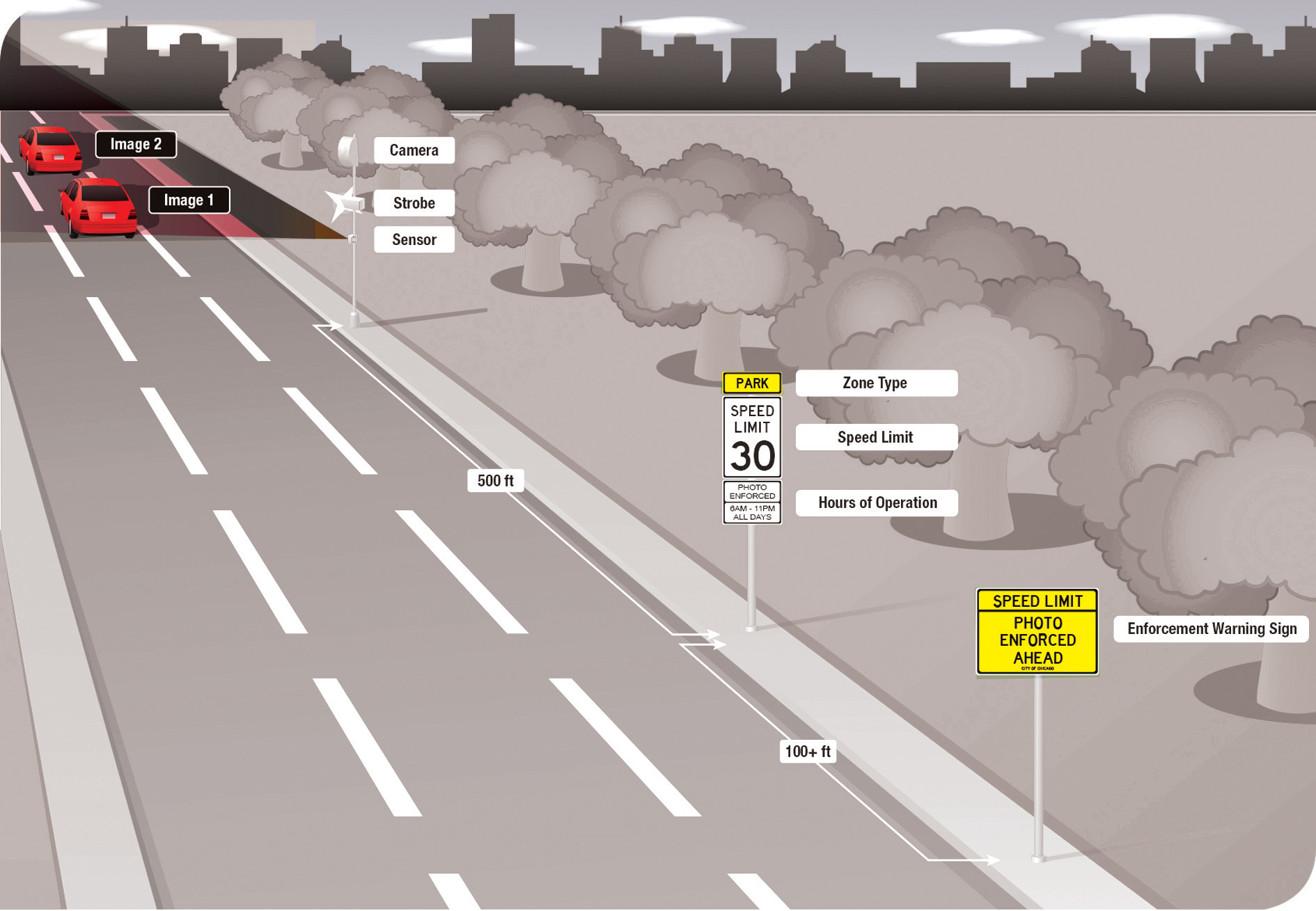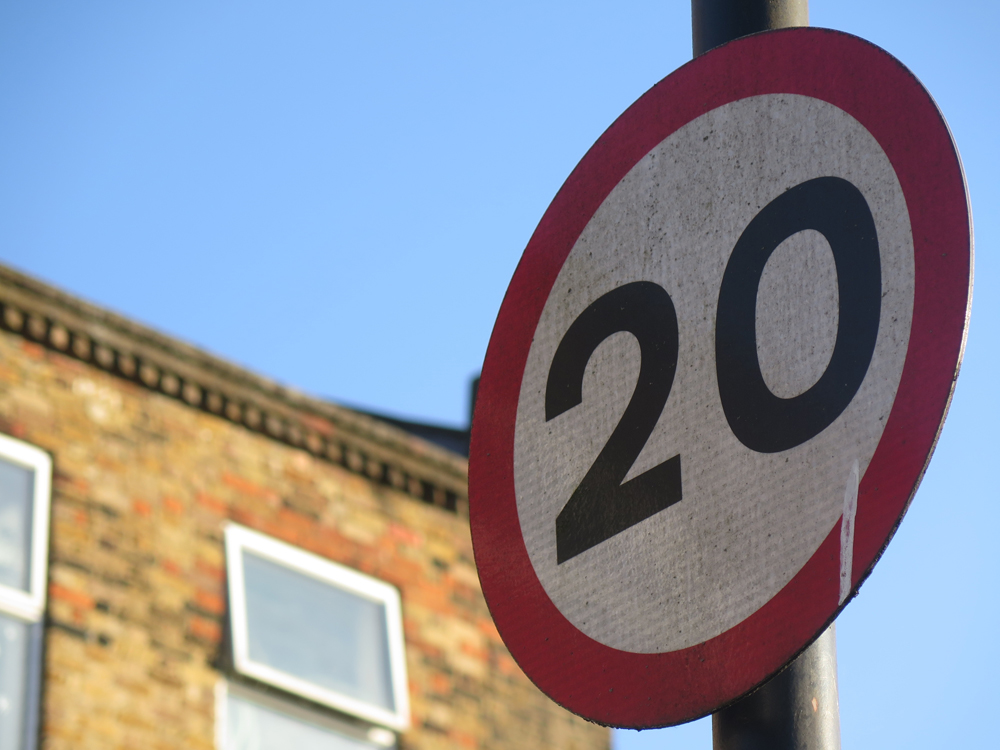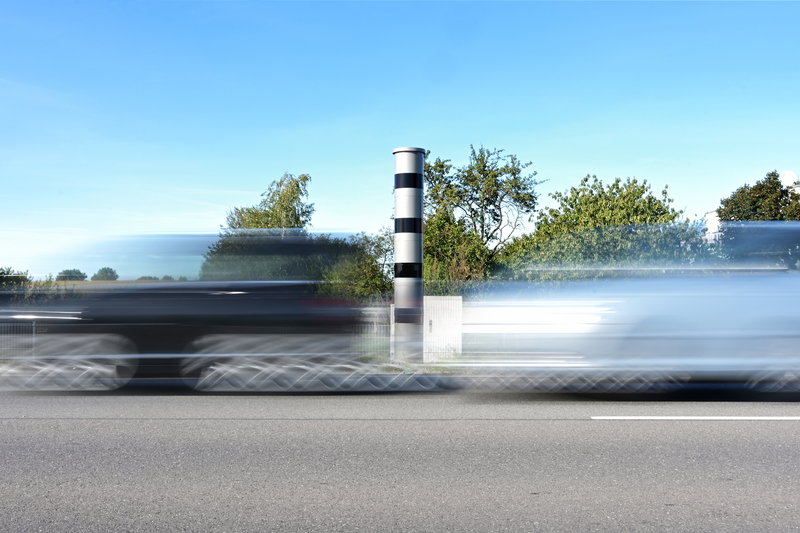Chicago is installing automated enforcement after pilot schemes indicated that one in 10 motorists exceed the speed limits in Children’s Safety Zones. Each year in Chicago there are around 3,000 incidents of pedestrians being struck by a motor vehicle - and about 800 of those casualties are children. In an effort to improve child safety the Chicago Department of Transportation (CDOT) has established Children’s Safety Zones around schools and other areas where children congregate. These zones allow the impos

Extensive signage warns drivers they are approaching a Children’s Safety Zone
Chicago is installing automated enforcement after pilot schemes indicated that one in 10 motorists exceed the speed limits in Children’s Safety Zones.
Each year in Chicago there are around 3,000 incidents of pedestrians being struck by a motor vehicle - and about 800 of those casualties are children. In an effort to improve child safety the1001 Chicago Department of Transportation (CDOT) has established Children’s Safety Zones around schools and other areas where children congregate. These zones allow the imposition of a 32kmh (20mph) at certain times and are designated as within 220 metres (1/8th of a mile) of one of the city’s schools or parks.
Figures from the831 Federal Highway Administration indicate that a pedestrian hit by a car travelling 32kmh (20mph) has a 95% chance of living while if the car is going at more than 64kmh (40mph), there is an 80% chance that they will be killed.
CDOT Commissioner Gabe Klein said: “The Children’s Safety Zone Program protects children and other pedestrians by reminding motorists to slow down and obey speed laws, particularly in school and park zones.”
While extensive signage warns motorists entering one of these safety zones about the presence of children and the speed limits, experience on the ground indicated that motorists were ignoring the lower speed limit. This prompted CDOT to undertake a pilot scheme to test adherence to the speed limits in Children’s Safety Zones and with a view to installing automated enforcement cameras.
The city ordinance establishing the Children’s Safety Zone Program substantially limits the hours and locations of enforcement. Safety Zones around schools have their enforcement hours limited to between 7am and 7pm on week days. Between 7am and 4pm, and when children are present, the speed limit is lowered to 32kmh (20mph). When there are no children present, the limit reverts to 48kmh (30mph) as it does between 4pm and 7pm. Around the City’s parks the regulations stipulate the zones have a 48kmh (30mph) speed limit during the park’s opening hours (typically 6am to 11pm) and these operate throughout the year.
Four pilot studies were conducted by two potential suppliers American Traffic Solutions (ATS) and4186 Xerox. These pilots were designed to both detect and quantify any speeding in the Zones and the locations for these pilot tests were selected for their high traffic volumes in order to fully test the equipment and system capabilities. The results from these pilots indicated that almost 10% of motorists were exceeding the 32kmh (20mph) school time speed limit.
While this pilot data is not typical of all Children’s Safety Zone in terms of volume Charles Territo, senior vice president at ATS, believes the driver behaviour patterns are representative. She said: “There is no question that there is speeding problem in School and Park Zones throughout the city.
ATS had two pilot test locations and of the more than 547,000 vehicles that passed through the monitored Safety Zones during enforcement hours, more than 51,700 (almost 10%), were exceeding the posted speed limit.
Outside Dulles Elementary School at 6300 S. Martin Luther King Blvd., the pilot showed that 18% of the vehicles passing through during enforcement hours had potential speeding violations. On average speeding motorists was measured at more than 14kmh (9 mph) over the posted 32kmh (20mph) school-hours speed limit, with the fastest measured at 93kmh (58mph) even though there was a pedestrian present.
Results from the second ATS test site near Warren Park at 6500 N. Western Ave, show that about 7% of all motorists were exceeding the 48kmh (30mph) limit by an average of more than 13kmh (8mph). The fastest motorist was recorded at 96kmh (60mph).
At the Xerox pilot site close to the North Montessori School, 1446 W. Division St., Xerox found 9% of vehicles speeding, an average of 30 violations per hour or 366 per day. At its second site near McKinley Park, at 2223 W. Pershing Rd, Xerox recorded 8% of drivers exceeding the speed limit and found an average of 57 violations per hour or 974 each day.
“These pilot tests confirm that speeding is problem and that it puts children in danger. Speed is also one of the biggest determinants in whether an accident results in a serious injury or fatality, and reducing speeds to the posted limits will reduce injuries and save lives,” Klein said.
City officials identified and initial 12 Children’s Safety Zones for the installation of automated enforcement equipment and have now identified 50 locations where cameras will be installed by the end of 2013. To ensure the program will enhance safety and reduce speeding citywide, and to help ensure geographic balance, six regions have been established wherein no fewer than 10% of speed enforcement cameras will be located in each region.
In operation, during the 32kmh (20mph) enforcement hours, the cameras’ trigger speed is lowered so the license plates of all vehicles exceeding that speed will be captured. All violations are first examined for evidence of vehicle speed and then both video and still images are reviewed to determine whether or not children were present. The back office administration is being handled by a combination of staff working for ATS,62 IBM and the City of Chicago.
In addition to regulating the operating times, the legislation under which the Children’s Safety Zones are established also specifies the penalties that can be applied to motorists caught speeding by the camera systems. For instance in the first 30 days after cameras are installed in a Safety Zone errant drivers will only be issued with a warning and the first time a vehicle owner is eligible to receive an actual ticket, they will instead receive a warning.
Those continuing to speed can expect a $35 fine for travelling at 10 – 16kmh (6-10mph) faster than the posted Safety Zone speed limit and this rises to $100 if the vehicles is travelling at 18kmh (11mph) or more above the limit.
The automated speed enforcement cameras are only one part of the City’s approach to enhancing safety for residents and especially children. Other initiatives include speed feedback signs and speed humps, high-visibility crosswalk markings and pedestrian refuge islands in crosswalks, pedestrian countdown timers and in-street “Stop for Pedestrians” signs. Revenue generated by the fines will be invested in other these and other safety initiatives including after-school, anti-violence and jobs programs, crossing guards and police officers around schools.
Territo said: The hope is that this program can change driver behavior by enforcing speed limits alerting drivers to the dangers of excessive speeding. Commissioner Klein goes even further saying he expects the scheme to “… reduce the amount of speeding substantially, even beyond what other cities that use automated enforcement have experienced.”
With the new school year already underway, the results shouldn’t be long in coming.
Each year in Chicago there are around 3,000 incidents of pedestrians being struck by a motor vehicle - and about 800 of those casualties are children. In an effort to improve child safety the
Figures from the
CDOT Commissioner Gabe Klein said: “The Children’s Safety Zone Program protects children and other pedestrians by reminding motorists to slow down and obey speed laws, particularly in school and park zones.”
While extensive signage warns motorists entering one of these safety zones about the presence of children and the speed limits, experience on the ground indicated that motorists were ignoring the lower speed limit. This prompted CDOT to undertake a pilot scheme to test adherence to the speed limits in Children’s Safety Zones and with a view to installing automated enforcement cameras.
The city ordinance establishing the Children’s Safety Zone Program substantially limits the hours and locations of enforcement. Safety Zones around schools have their enforcement hours limited to between 7am and 7pm on week days. Between 7am and 4pm, and when children are present, the speed limit is lowered to 32kmh (20mph). When there are no children present, the limit reverts to 48kmh (30mph) as it does between 4pm and 7pm. Around the City’s parks the regulations stipulate the zones have a 48kmh (30mph) speed limit during the park’s opening hours (typically 6am to 11pm) and these operate throughout the year.
Four pilot studies were conducted by two potential suppliers American Traffic Solutions (ATS) and
While this pilot data is not typical of all Children’s Safety Zone in terms of volume Charles Territo, senior vice president at ATS, believes the driver behaviour patterns are representative. She said: “There is no question that there is speeding problem in School and Park Zones throughout the city.
ATS had two pilot test locations and of the more than 547,000 vehicles that passed through the monitored Safety Zones during enforcement hours, more than 51,700 (almost 10%), were exceeding the posted speed limit.
Outside Dulles Elementary School at 6300 S. Martin Luther King Blvd., the pilot showed that 18% of the vehicles passing through during enforcement hours had potential speeding violations. On average speeding motorists was measured at more than 14kmh (9 mph) over the posted 32kmh (20mph) school-hours speed limit, with the fastest measured at 93kmh (58mph) even though there was a pedestrian present.
Results from the second ATS test site near Warren Park at 6500 N. Western Ave, show that about 7% of all motorists were exceeding the 48kmh (30mph) limit by an average of more than 13kmh (8mph). The fastest motorist was recorded at 96kmh (60mph).
At the Xerox pilot site close to the North Montessori School, 1446 W. Division St., Xerox found 9% of vehicles speeding, an average of 30 violations per hour or 366 per day. At its second site near McKinley Park, at 2223 W. Pershing Rd, Xerox recorded 8% of drivers exceeding the speed limit and found an average of 57 violations per hour or 974 each day.
“These pilot tests confirm that speeding is problem and that it puts children in danger. Speed is also one of the biggest determinants in whether an accident results in a serious injury or fatality, and reducing speeds to the posted limits will reduce injuries and save lives,” Klein said.
City officials identified and initial 12 Children’s Safety Zones for the installation of automated enforcement equipment and have now identified 50 locations where cameras will be installed by the end of 2013. To ensure the program will enhance safety and reduce speeding citywide, and to help ensure geographic balance, six regions have been established wherein no fewer than 10% of speed enforcement cameras will be located in each region.
In operation, during the 32kmh (20mph) enforcement hours, the cameras’ trigger speed is lowered so the license plates of all vehicles exceeding that speed will be captured. All violations are first examined for evidence of vehicle speed and then both video and still images are reviewed to determine whether or not children were present. The back office administration is being handled by a combination of staff working for ATS,
In addition to regulating the operating times, the legislation under which the Children’s Safety Zones are established also specifies the penalties that can be applied to motorists caught speeding by the camera systems. For instance in the first 30 days after cameras are installed in a Safety Zone errant drivers will only be issued with a warning and the first time a vehicle owner is eligible to receive an actual ticket, they will instead receive a warning.
Those continuing to speed can expect a $35 fine for travelling at 10 – 16kmh (6-10mph) faster than the posted Safety Zone speed limit and this rises to $100 if the vehicles is travelling at 18kmh (11mph) or more above the limit.
The automated speed enforcement cameras are only one part of the City’s approach to enhancing safety for residents and especially children. Other initiatives include speed feedback signs and speed humps, high-visibility crosswalk markings and pedestrian refuge islands in crosswalks, pedestrian countdown timers and in-street “Stop for Pedestrians” signs. Revenue generated by the fines will be invested in other these and other safety initiatives including after-school, anti-violence and jobs programs, crossing guards and police officers around schools.
Territo said: The hope is that this program can change driver behavior by enforcing speed limits alerting drivers to the dangers of excessive speeding. Commissioner Klein goes even further saying he expects the scheme to “… reduce the amount of speeding substantially, even beyond what other cities that use automated enforcement have experienced.”
With the new school year already underway, the results shouldn’t be long in coming.









